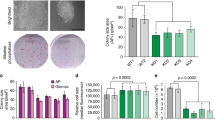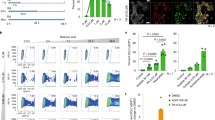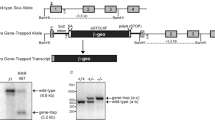Abstract
The retinoblastoma (Rb) gene was the first tumour suppressor identified1. Inactivation of Rb in mice results in unscheduled cell proliferation, apoptosis and widespread developmental defects, leading to embryonic death by day 14.5 (refs 2–4). However, the actual cause of the embryonic lethality has not been fully investigated. Here we show that loss of Rb leads to excessive proliferation of trophoblast cells and a severe disruption of the normal labyrinth architecture in the placenta. This is accompanied by a decrease in vascularization and a reduction in placental transport function. We used two complementary techniques—tetraploid aggregation and conditional knockout strategies—to demonstrate that Rb-deficient embryos supplied with a wild-type placenta can be carried to term, but die soon after birth. Most of the neurological and erythroid abnormalities thought to be responsible for the embryonic lethality of Rb-null animals were virtually absent in rescued Rb-null pups. These findings identify and define a key function of Rb in extra-embryonic cell lineages that is required for embryonic development and viability, and provide a mechanism for the cell autonomous versus non-cell autonomous roles of Rb in development.
This is a preview of subscription content, access via your institution
Access options
Subscribe to this journal
Receive 51 print issues and online access
$199.00 per year
only $3.90 per issue
Buy this article
- Purchase on Springer Link
- Instant access to full article PDF
Prices may be subject to local taxes which are calculated during checkout




Similar content being viewed by others
References
Nevins, J. R. The Rb/E2F pathway and cancer. Hum. Mol. Genet. 10, 699–703 (2001)
Lee, E. Y. et al. Mice deficient for Rb are nonviable and show defects in neurogenesis and haematopoiesis. Nature 359, 288–294 (1992)
Jacks, T. et al. Effects of an Rb mutation in the mouse. Nature 359, 295–300 (1992)
Clarke, A. R. et al. Requirement for a functional Rb-1 gene in murine development. Nature 359, 328–330 (1992)
Zhang, P., Wong, C., DePinho, R. A., Harper, J. W. & Elledge, S. J. Cooperation between the Cdk inhibitors p27(KIP1) and p57(KIP2) in the control of tissue growth and development. Genes Dev. 12, 3162–3167 (1998)
Faria, T. N., Ogren, L., Talamantes, F., Linzer, D. I. H. & Soares, M. J. Localization of placental lactogen-I in trophoblast giant cells of the mouse placenta. Biol. Reprod. 44, 327–331 (1991)
Linzer, D. I., Lee, S. J., Ogren, L., Talamantes, F. & Nathans, D. Identification of proliferin mRNA and protein in mouse placenta. Proc. Natl Acad. Sci. USA 82, 4356–4359 (1985)
Lescisin, K. R., Varmuza, S. & Rossant, J. Isolation and characterization of a novel trophoblast-specific cDNA in the mouse. Genes Dev. 2, 1639–1646 (1988)
Russ, A. P. et al. Eomesodermin is required for mouse trophoblast development and mesoderm formation. Nature 404, 95–99 (2000)
Tanaka, S., Kunath, T., Hadjantonakis, A. K., Nagy, A. & Rossant, J. Promotion of trophoblast stem cell proliferation by FGF4. Science 282, 2072–2075 (1998)
Metcalfe, L. D., Schmitz, A. A. & Pelka, J. R. Rapid preparation of fatty acid esters from lipids for gas chromatographic analysis. Anal. Chem. 38, 514–515 (1966)
James, R. M., Klerkx, A. H., Keighren, M., Flockhart, J. H. & West, J. D. Restricted distribution of tetraploid cells in mouse tetraploid↔diploid chimaeras. Dev. Biol. 167, 213–226 (1995)
Marino, S., Vooijs, M., van Der Gulden, H., Jonkers, J. & Berns, A. Induction of medulloblastomas in p53-null mutant mice by somatic inactivation of Rb in the external granular layer cells of the cerebellum. Genes Dev. 14, 994–1004 (2000)
Tallquist, M. D. & Soriano, P. Epiblast-restricted Cre expression in MORE mice: a tool to distinguish embryonic vs. extra-embryonic gene function. Genesis J. Genet. Dev. 26, 113–115 (2000)
Soriano, P. Generalized lacZ expression with the ROSA26 Cre reporter strain. Nature Genet. 21, 70–71 (1999)
Lipinski, M. M. & Jacks, T. The retinoblastoma gene family in differentiation and development. Oncogene 18, 7873–7882 (1999)
Copp, A. J. Death before birth: clues from gene knockouts and mutations. Trends Genet. 11, 87–93 (1995)
Cross, J. C., Werb, Z. & Fisher, S. J. Implantation and the placenta: key pieces of the development puzzle. Science 266, 1508–1518 (1994)
Lipinski, M. M. et al. Cell-autonomous and non-cell-autonomous functions of the Rb tumour suppressor in developing central nervous system. EMBO J. 20, 3402–3413 (2001)
Maandag, E. C. et al. Developmental rescue of an embryonic-lethal mutation in the retinoblastoma gene in chimeric mice. EMBO J. 13, 4260–4268 (1994)
Williams, B. O. et al. Extensive contribution of Rb-deficient cells to adult chimeric mice with limited histopathological consequences. EMBO J. 13, 4251–9425 (1994)
Zacksenhaus, E. et al. pRb controls proliferation, differentiation, and death of skeletal muscle cells and other lineages during embryogenesis. Genes Dev. 10, 3051–3064 (1996)
Tsai, K. Y. et al. Mutation of E2f-1 suppresses apoptosis and inappropriate S phase entry and extends survival of Rb-deficient mouse embryos. Mol. Cell 2, 293–304 (1998)
Ziebold, U., Reza, T., Caron, A. & Lees, J. A. E2F3 contributes both to the inappropriate proliferation and to the apoptosis arising in Rb mutant embryos. Genes Dev. 15, 386–391 (2001)
Lasorella, A., Noseda, M., Beyna, M., Yokota, Y. & Iavarone, A. Id2 is a retinoblastoma protein target and mediates signalling by Myc oncoproteins. Nature 407, 592–598 (2000)
Nagy, A., Rossant, J., Nagy, R., Abramow-Newerly, W. & Roder, J. C. Derivation of completely cell culture-derived mice from early-passage embryonic stem cells. Proc. Natl Acad. Sci. USA 90, 8424–8428 (1993)
Hogan, B., Beddington, R., Costantini, F. & Lacy, E. Manipulating the Mouse Embryo: a Laboratory Manual (Cold Spring Harbor Laboratory Press, Plainview, New York, 1994)
Kurz, H., Zechner, U., Orth, A. & Fundele, R. Lack of correlation between placenta and offspring size in mouse interspecific crosses. Anat. Embryol. 200, 335–343 (1999)
Anson-Cartwright, L. et al. The glial cells missing-1 protein is essential for branching morphogenesis in the chorioallantoic placenta. Nature Genet. 25, 311–314 (2000)
Acknowledgements
We thank A. Berns, P. Soriano and T. Jacks for providing Rb+/loxP, Mox2+/cre and Rb+/- mice, respectively. We also thank S. Hoshaw-Woodard and R. J. Jandacek for technical assistance, and C. Timmers for critical scientific discussions. This work was supported by grants from the National Cancer Institute (to G.L and T.J.R.), the National Institute of Health (to M.W. and G.L.), the National Center for Research Resources (to T.J.R.), and by the Canadian Institutes of Health Research (to J.C.C.). L.W., H.S. and A.T. were supported by NIH awards, A.d.B. was supported by a UOR Human Cancer Genetics Postdoctoral Fellowship, and G.L. is a V-Foundation and PEW Scholar.
Author information
Authors and Affiliations
Corresponding author
Ethics declarations
Competing interests
The authors declare that they have no competing financial interests.
Rights and permissions
About this article
Cite this article
Wu, L., de Bruin, A., Saavedra, H. et al. Extra-embryonic function of Rb is essential for embryonic development and viability. Nature 421, 942–947 (2003). https://doi.org/10.1038/nature01417
Received:
Accepted:
Issue Date:
DOI: https://doi.org/10.1038/nature01417
This article is cited by
-
Shifting the paradigms for tumor suppression: lessons from the p53 field
Oncogene (2021)
-
Mechanisms of early placental development in mouse and humans
Nature Reviews Genetics (2020)
-
Rb is required for retinal angiogenesis and lamination
Cell Death & Disease (2018)
-
Placentation defects are highly prevalent in embryonic lethal mouse mutants
Nature (2018)
-
Deletion of the Syncytin A receptor Ly6e impairs syncytiotrophoblast fusion and placental morphogenesis causing embryonic lethality in mice
Scientific Reports (2018)
Comments
By submitting a comment you agree to abide by our Terms and Community Guidelines. If you find something abusive or that does not comply with our terms or guidelines please flag it as inappropriate.



